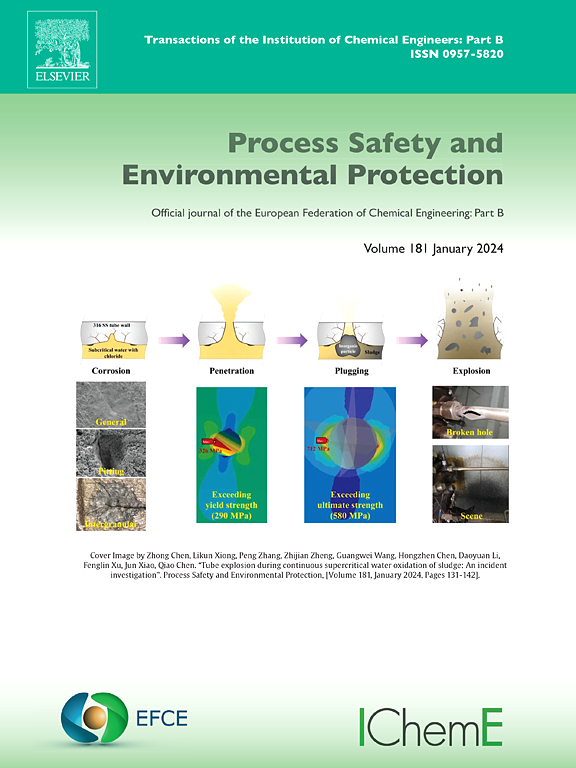煤矿事故因果网络保护策略研究:考虑节点重要性和成本投入
IF 7.8
2区 环境科学与生态学
Q1 ENGINEERING, CHEMICAL
引用次数: 0
摘要
针对煤矿事故频发的特点,识别和防范关键因果节点,是保障煤矿安全生产的关键。虽然煤矿事故具有复杂性和网络特征,但现有研究很少考虑节点保护投资成本的变化对复杂事故网络鲁棒性的影响。此外,目前评估节点重要性的方法没有充分整合对网络拓扑结构的综合分析。为了填补这些空白,本研究创建了一种使用TOPSIS方法评估煤矿事故网络中节点重要性的方法,允许对网络中每个节点的重要性进行彻底分析。在此基础上,利用遗传优化算法建立了具有成本约束的最优保护策略模型,研究了煤矿事故复杂网络中的节点保护问题。通过对中国实际煤矿事故的分析,验证了该方法的有效性。结果表明,考虑网络拓扑结构的节点重要性评价方法可以更有效地识别关键节点,并综合反映其在网络中的重要性。与5种备选保护策略相比,最优保护策略在保护成本预算不受影响的情况下具有更优的性能。该研究为事故预防节点投资的成本分配提供了有价值的见解,旨在降低事故发生率。本文章由计算机程序翻译,如有差异,请以英文原文为准。
Research on protection strategies for the causal network of coal mine accidents: Considering node importance and cost investment
In response to the frequent occurrence characteristics of coal mine accidents, identifying and preventing critical causal nodes is crucial for ensuring the safe production of coal mines. While coal mine accidents exhibit complexity and network characteristics, existing research rarely considers the impact of variations in the costs of investing in node protection on the robustness of complex accident networks. Moreover, current methods for evaluating node importance inadequately integrate a comprehensive analysis of network topological structure. To fill these gaps, this study creates a method to evaluate the importance of nodes in coal mine accident networks using the TOPSIS approach, allowing for a thorough analysis of how important each node is in the network. Furthermore, an optimal protection strategy model with cost constraints is developed using genetic optimization algorithms to investigate node protection in complex networks of coal mine accidents. We analyzed practical coal mine accidents in China to validate the effectiveness of the proposed method. The results demonstrate that the method for evaluating node importance considering network topology can more effectively identify critical nodes and comprehensively reflect their importance within the network. Compared with five alternative strategies, the optimal protection strategy achieves superior performance regardless of variations in protection cost budgets. This research provides valuable insights for cost allocation in accident prevention node investment, aiming to reduce accident occurrence rates.
求助全文
通过发布文献求助,成功后即可免费获取论文全文。
去求助
来源期刊

Process Safety and Environmental Protection
环境科学-工程:化工
CiteScore
11.40
自引率
15.40%
发文量
929
审稿时长
8.0 months
期刊介绍:
The Process Safety and Environmental Protection (PSEP) journal is a leading international publication that focuses on the publication of high-quality, original research papers in the field of engineering, specifically those related to the safety of industrial processes and environmental protection. The journal encourages submissions that present new developments in safety and environmental aspects, particularly those that show how research findings can be applied in process engineering design and practice.
PSEP is particularly interested in research that brings fresh perspectives to established engineering principles, identifies unsolved problems, or suggests directions for future research. The journal also values contributions that push the boundaries of traditional engineering and welcomes multidisciplinary papers.
PSEP's articles are abstracted and indexed by a range of databases and services, which helps to ensure that the journal's research is accessible and recognized in the academic and professional communities. These databases include ANTE, Chemical Abstracts, Chemical Hazards in Industry, Current Contents, Elsevier Engineering Information database, Pascal Francis, Web of Science, Scopus, Engineering Information Database EnCompass LIT (Elsevier), and INSPEC. This wide coverage facilitates the dissemination of the journal's content to a global audience interested in process safety and environmental engineering.
 求助内容:
求助内容: 应助结果提醒方式:
应助结果提醒方式:


